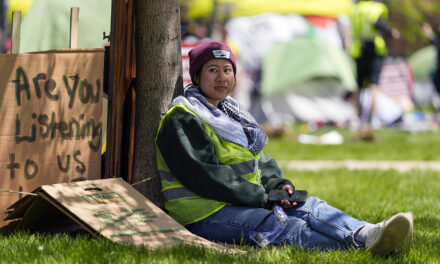We support our Publishers and Content Creators. You can view this story on their website by CLICKING HERE.
Ukrainian soldiers carry shells to fire at Russian positions on the front line, near the city of Bakhmut, in Ukraine’s Donetsk region, on March 25, 2024. The $61 billion package for Ukraine signed by President Biden puts the country a step closer to getting an infusion of new firepower. But the clock is ticking. Russia is using all its might to achieve its most significant gains since the invasion by a May 9 deadline.
As Ukraine desperately awaits the arrival of new U.S. weapons and equipment approved last month, Russia is seeking to make the most of the remaining window.
Moscow’s forces in the past week have taken several villages in eastern Ukraine after Kyiv’s threadbare army ceded ground, and they are positioned to secure additional territory in the days ahead.
Russia’s relentless missile and drone strikes have also been increasingly effective as Ukraine runs short on defensive weapons to counter the attacks.
But Russia’s window for exploiting Ukraine’s weakness is swiftly closing, with limited time before American weapons flood the battlefield and reinvigorate the Ukrainian forces, experts say.
“Knowing that the renewed aid is on the way, Ukraine’s stiffening up their defenses. I think [Russians] are still trying to sort of push as the window closes,” Steven Horrell, a nonresident senior fellow with the Center for European Policy Analysis, told The Hill.
And Michael O’Hanlon, an expert with the Brookings Institution think tank in Washington, said Russia’s forces could “pick up the pace, and the carnage, by 10 to 20 percent” in the gap between the U.S. announcing new aid last week and when those weapons reach Ukrainian troops.
The Defense Department last week announced a $1 billion package for Ukraine shortly after President Biden signed a national security supplemental into law. Much of the weapons tranche, which aims to deliver critical artillery rounds and air defense munitions to Kyiv, was already pre-positioned in Europe to be able to quickly move it into Ukraine, according to the Pentagon.
“As soon as we were able to announce that $1 billion … we were ready to support Ukraine almost immediately,” Pentagon deputy press secretary Sabrina Singh said Wednesday.
She was not able to say, however, whether the lethal assistance had reached the front lines and the units that need them the most.
Another $6 billion package announced last week was not from U.S. stocks, and could take months if not years to get to Ukraine.
U.S. and Ukrainian officials and lawmakers lauded the passage of the $95 billion supplemental, which includes roughly $61 billion to support Kyiv, but Congress’s months-long delay before sending the bill to Biden’s desk proved damaging to the embattled country.
Most U.S. assistance to Ukraine dried up at the end of 2023, making Ukrainian troops desperate for ammunition and air defenses as Russia pressed forward on the battlefield and pummeled key cities and energy infrastructure with artillery, drones and bombs.
“It is good that Congress finally passed the aid package to Ukraine. The months of delay were very costly,” Rep. Adam Smith (D-Wash.) said during a House Armed Services Committee hearing Tuesday.
Shortly after the latest U.S. assistance was announced, Ukrainian troops pulled back from several villages captured by Russia’s army in the eastern Donetsk region, including Berdychi, Semenivka and Novomykhailivka.
Ukraine’s commander in chief, Col. Gen. Oleksandr Syrskyi, said Sunday that the “situation at the front has worsened” and that Russia had used its advantage in men and ammunition to push toward the towns of Kurakhove and Pokrovsk, also in the Donetsk.
In addition, Moscow’s military is pressing to capture Ocheretyne, a small rural town in eastern Ukraine where Kyiv’s forces are struggling to hold the defensive line, according to a battlefield assessment released Wednesday by Hudson Institute.
“Last week, Moscow’s widening artillery advantage and Kyiv’s stumbling mobilization efforts allowed Russian forces to make significant battlefield advances and tactical gains on multiple fronts,” the assessment found.
“In the meantime, Russian air and missile strikes continued to pound major Ukrainian population centers.”
And the Institute for the Study of War reported Monday that “Russian forces will likely continue to make tactical gains” around the major town of Avdiivka in the coming weeks.
Russia has been pushing ahead more aggressively this spring, in part to seize the initiative after the delay of U.S. aid to Ukrainian defenders.
John Herbst, the former U.S. ambassador to Ukraine, predicted Russia may speed up its offensive — which was launched in mid-fall — given the speed with which the U.S. is flowing its aid into Ukraine.
“It certainly is a greater period of danger until a good bulk of the aid arrives,” said Herbst, now a senior director of the Atlantic Council’s Eurasia Center.
But he added that he believes the most dangerous moment has already passed, given that the Ukrainians, in turn, have stepped up their use of weapons they have rationed since last fall, with the knowledge that they will soon be backfilled.
“I think they’ll lose very little or no territory, starting in two to three or four weeks,” Herbst said of the Ukrainians.
Russia-Ukraine war
Ukraine aid
Copyright 2024 Nexstar Media Inc. All rights reserved. This material may not be published, broadcast, rewritten, or redistributed.

 Conservative
Conservative  Search
Search Trending
Trending Current News
Current News 





